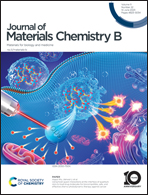A molecularly imprinted fiber array solid-phase microextraction strategy for simultaneous detection of multiple estrogens†
Abstract
A kind of selective enrichment material based on a homemade molecularly imprinted polymer (MIP) fiber array with high adsorption capacity was developed for the accurate analysis of estrogens in food samples. Here, the MIP with 17β-estradiol as the template was obtained by in situ polymerization. The chemical composition, morphologies, surface area, and pore size of the polymer were characterized by Fourier transform infrared spectroscopy, scanning electron microscopy, and Brunauer–Emmett–Teller theory. The extraction time, desorption solvent, desorption time, ionic strength, and the pH of solution were investigated to ascertain the best extraction conditions. Under the optimal extraction conditions, three fiber coatings of 17β-estradiol MIP and commercial polyacrylate (PA) were bound to a homemade handle to assemble the fiber array, respectively. The findings showed that the three-fiber array of the MIP significantly improved the extraction capacity by 145 times compared to PA. The MIP fiber array showed high adsorption capacity for the template molecule 17β-estradiol and its structural analogues estrone, bisphenol F, bisphenol B, and bisphenol A, with enrichment factors of 99.60–133.16. A molecularly imprinted polymer solid-phase microextraction fiber array (MIP-SPME fiber array) coupled with high-performance liquid chromatography-diode array detection was used for the analysis and detection of the five estrogens in milk and yogurt samples. Satisfactory recoveries were achieved ranging from 74.75–119.41% with <9.42% relative standard deviations. The developed method for the simultaneous determination of trace estrogens in food samples exhibited a limit of detection of 0.33 μg L−1. The MIP-SPME fiber array provided an available strategy for improving the selectivity and adsorption capacity of SPME for trace target component analysis in complex matrices and increasing the sensitivity of the analytical method.



 Please wait while we load your content...
Please wait while we load your content...